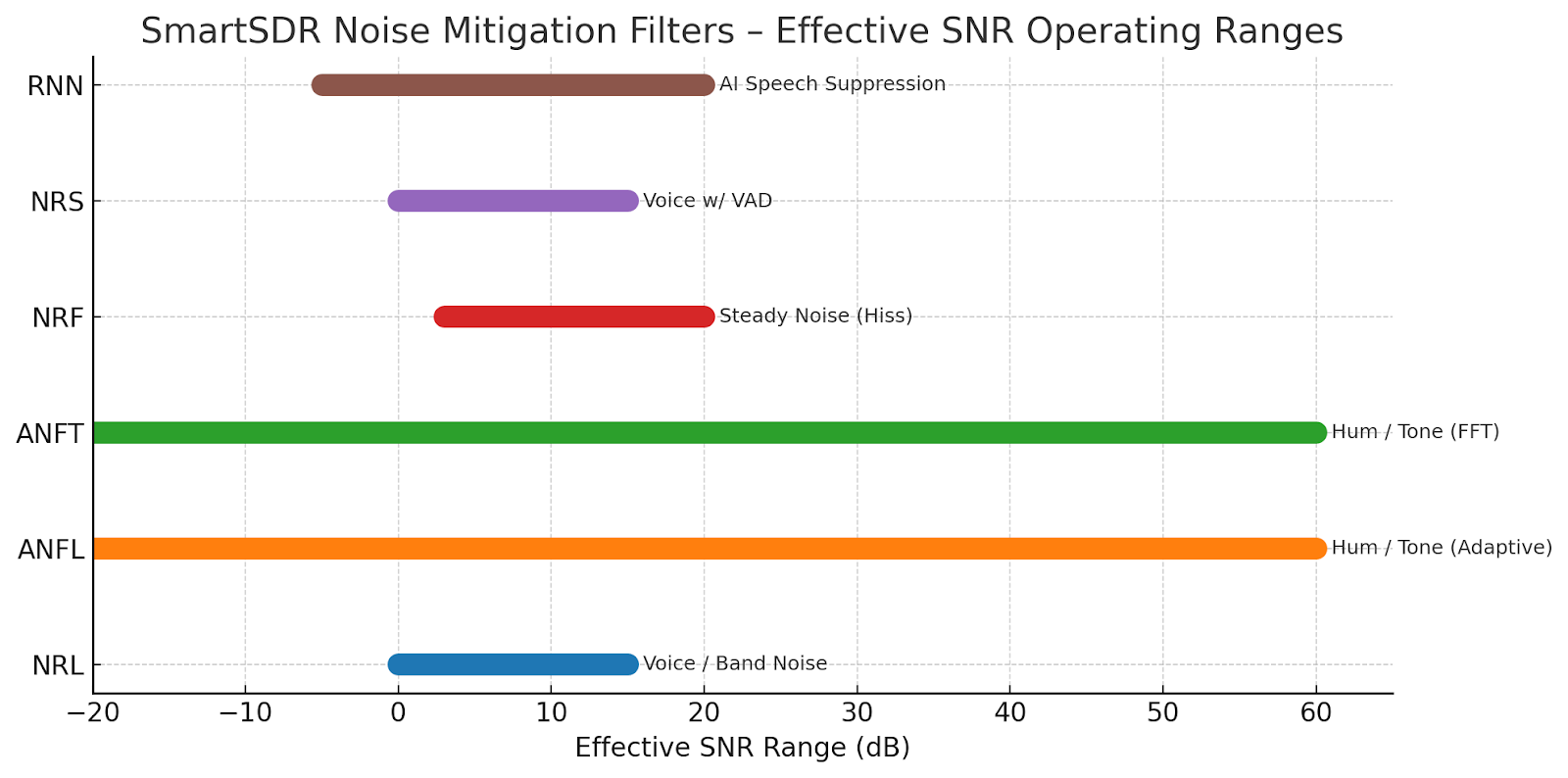SmartSDR v4.1.3 | SmartSDR v4.1.3 Release Notes
SmartSDR v3.10.15 | SmartSDR v3.10.15 Release Notes
The latest 4O3A Genius Product Software and Firmware
Need technical support from FlexRadio? It's as simple as Creating a HelpDesk ticket.
SmartSDR v4 – Noise Mitigation Quick Reference

Comments
-
When is FLEX radio going to give features we used to have back us??? I have asked this question ever since you folks started charging for your updated software and Version 4. I used to take care of my noisy environment here in the city, but now I can't. You guys took away the adjustment for the Noise Blanker and a few other noise mitigation tools. What are you thinking I now have SmartSDR Early Access and I still can't adjust anything. Come on FLEX. You just made my 6400M into a SWAN 500.
3 -
Hey @Mike-VA3MW — thanks for the chart. Can you/Tim clarify one point for me? It says : "no user-adjustable parameters" — is that "we thought it was one-size-fits-all so we took out the sliders"? Or "no adjustment possible", as in, "there's nowhere in this new code for the user to provide hints to the NR"?
0 -
I’ve also wondered why user adjustments to the noise reduction algorithms were removed. However, since multiple algorithms can be used together, giving each one its own adjustment slider would make the Maestro’s interface overwhelmingly large. On top of that, the number of possible combinations would be practically endless, meaning the time spent filtering through them would take far too long. Overall - I love some of the new filters, I just have to remeber that some of the new ones take 1 to 3 seconds to realy take effect.-1
-
Using the new filter from SamrtSDR+ EarlyAcces
My primary use try to mitigate the noise for weak DX station
RNN for DX Station in noise, the signal disappear unusable for week signal in noise, the voice rx cutoff on-off-on-off sequence, lost the complete message, i cant use this, maybe if can adjust the level of the filter (now it is fixed), only work for reduce noise in signal S6+ for ragshew
NRS Reduce the noise a bit more than NR, the combination of the NR and NRS is the best approach for noise reduction but don’t enough
NRL for weak signal add watery noise
NRF add like eco to the weak signal
0 -
Here is the very approximate ranges:
🔹 General Rule of Thumb
Most digital noise reduction systems in SmartSDR (and SDRs in general) perform best when the SNR of the desired signal is between about 0 dB and +20 dB.
Below 0 dB, there’s too little structure for the algorithms to reliably distinguish signal from noise.
Above +20 dB, the noise is already low enough that filtering offers little benefit and may start to color the audio unnecessarily.Filter-by-Filter SNR Guidelines
NRL – Noise Reduction Leaky
- Optimal SNR Range: ≈ 0 dB → +15 dB
- Why: NRL relies on correlation detection — it can track structured content like speech or CW as long as there’s at least a small margin above the noise floor.
- Below 0 dB: The filter struggles to lock onto the desired signal and may flatten or “wash out” speech.
- Above +15 dB: Little improvement; may add mild “watery” artifacts.
ANFL – Adaptive Notch Filter Leaky
- Optimal SNR Range: Any SNR (works even with negative SNR)
- Why: It targets tonal interference, not random noise, so it doesn’t depend on SNR of the desired signal — only on the strength of the interfering tone relative to total signal power.
- Rule: The tone must be at least 10 dB stronger than the background to be recognized and notched effectively.
ANFT – Adaptive Notch Filter FFT
- Optimal SNR Range: Any, provided tone amplitude ≥ –110 dBFS and ≥ 10 dB above background.
- Why: FFT-based detection looks for narrow, stable spectral peaks. SNR of the main signal is largely irrelevant; what matters is tone prominence.
- Caution: In very low SNR conditions with fluctuating tones, detection latency may increase.
NRF – Noise Reduction Filter
- Optimal SNR Range: +3 dB → +20 dB
- Why: Spectral subtraction assumes the signal spectrum is distinct from the stationary noise floor.
- Below +3 dB: Noise and signal spectra overlap, causing audible “musical noise” or speech clipping.
- Above +20 dB: Filtering has negligible benefit.
NRS – Noise Reduction Speech
- Optimal SNR Range: 0 dB → +15 dB
- Why: The VAD component can detect speech reliably down to about 0 dB SNR; below that, it may misclassify weak speech as noise during syllable gaps.
- Benefit: Best audible quieting for average voice signals near the noise floor (3–10 dB SNR typical).
RNN – Recurrent Neural Network
- Operational SNR Range: –5 dB → +20 dB
- Why: The neural network is trained to recover speech even when buried below noise — it can function at slightly negative SNR because it models speech characteristics rather than statistical separation.
- Below –5 dB: Speech recovery becomes unreliable; noise dominates all features.
- Above +15 dB: Processing may subtly dull transients; otherwise transparent.
🔹 Summary Table
Filter
Best SNR Range (approx.)
Notes
NRL
0 → +15 dB
Adaptive LMS; needs correlated content.
ANFL
Any; tone ≥ +10 dB over noise
Works on tonal hums, not dependent on SNR.
ANFT
Any; tone ≥ –110 dBFS and ≥ 10 dB above background
Multi-tone FFT notch; tone prominence matters.
NRF
+3 → +20 dB
Spectral subtraction; best for steady noise.
NRS
0 → +15 dB
Adds voice activity detection for speech.
RNN
–5 → +20 dB
Deep-learning model; effective even below noise.
Takeaway
- For weak voice signals (SNR 0–10 dB): Try RNN, NRS, or NRL.
- For steady hums or carriers: Use ANFL or ANFT — they’re insensitive to speech SNR.
- For clean but slightly noisy audio (> 10 dB SNR): NRF provides subtle polish.
- For deep noise (negative SNR): Only RNN has any hope of recovering intelligible speech.
4 - Optimal SNR Range: ≈ 0 dB → +15 dB
-
Thanks Mike, great insight
1 -
Mike don't judge me, even though I've been a Flex fan since 2005, but in this period I'm using and I recommend you test Thetis, you'll see how NR and NB work as well as lots of free news
lou
3 -
Mike. All these filter option are great if you own an 8000 series. They are currently greyed out on my 6600 and some aren’t even available. NR, NB, AND ANF are either On or Off. No level adjustment possible. NR does not work as well as it did on v3. Please bring back the sliders.
5 -
2 thumbs up on the new upgrade. Noise setting are working great.
2 -
I remember when we used to pay big $$$ for filters. None of them were this good. 😀
1 -
Outstanding! but I can not remember ?
0 -
There was an error rendering this rich post.
0 -
Hi,
I share some of the comments above about these new filters being worse than V3. The only one that seems to make any difference on CW is NR and that difference is slight. Neither APF nor NRL seem to do anything. The others have no effect or make the sound worse. Is there some trick to making these work?
Regards,
James Charlton
8600M0 -
total silence from the Flex staff
1 -
By selecting AGC: Fast, cw pitch at 700 Hz, using NRS this will lower the background noise for very weak signals copy at 250 hz bandwidth. Of course my normal local 40 m noise -105 dB (S4, 250 hz), 20 m - 10 m are -118 dB (S3) all on yagi.
Very difficult to compare a location to another.
0
Leave a Comment
Categories
- All Categories
- 378 Community Topics
- 2.1K New Ideas
- 630 The Flea Market
- 8.2K Software
- 116 SmartSDR+
- 6.4K SmartSDR for Windows
- 183 SmartSDR for Maestro and M models
- 428 SmartSDR for Mac
- 271 SmartSDR for iOS
- 258 SmartSDR CAT
- 191 DAX
- 382 SmartSDR API
- 9.3K Radios and Accessories
- 37 Aurora
- 254 FLEX-8000 Signature Series
- 7.2K FLEX-6000 Signature Series
- 945 Maestro
- 55 FlexControl
- 865 FLEX Series (Legacy) Radios
- 923 Genius Products
- 462 Power Genius XL Amplifier
- 336 Tuner Genius XL
- 125 Antenna Genius
- 296 Shack Infrastructure
- 208 Networking
- 458 Remote Operation (SmartLink)
- 144 Contesting
- 787 Peripherals & Station Integration
- 139 Amateur Radio Interests
- 1K Third-Party Software





